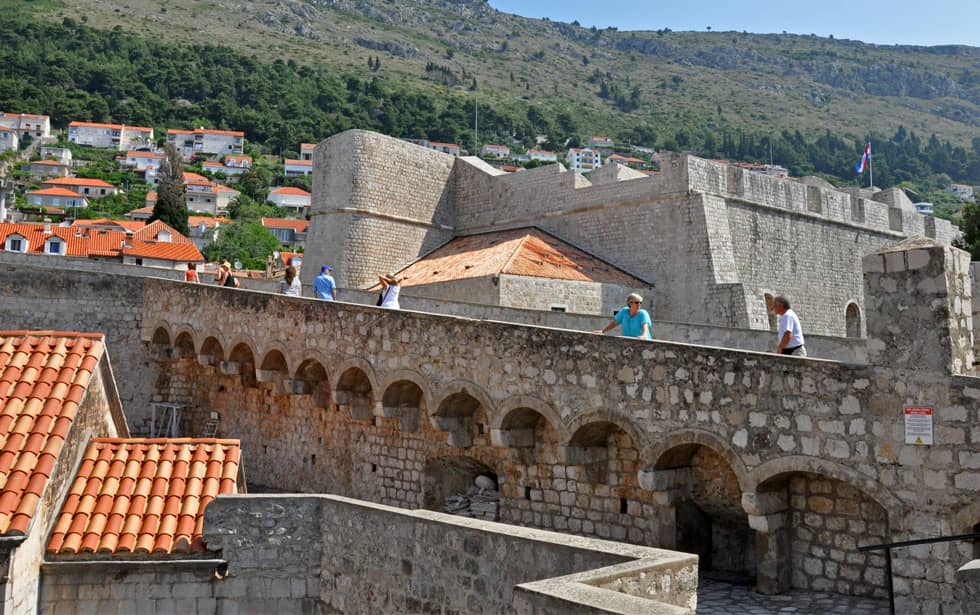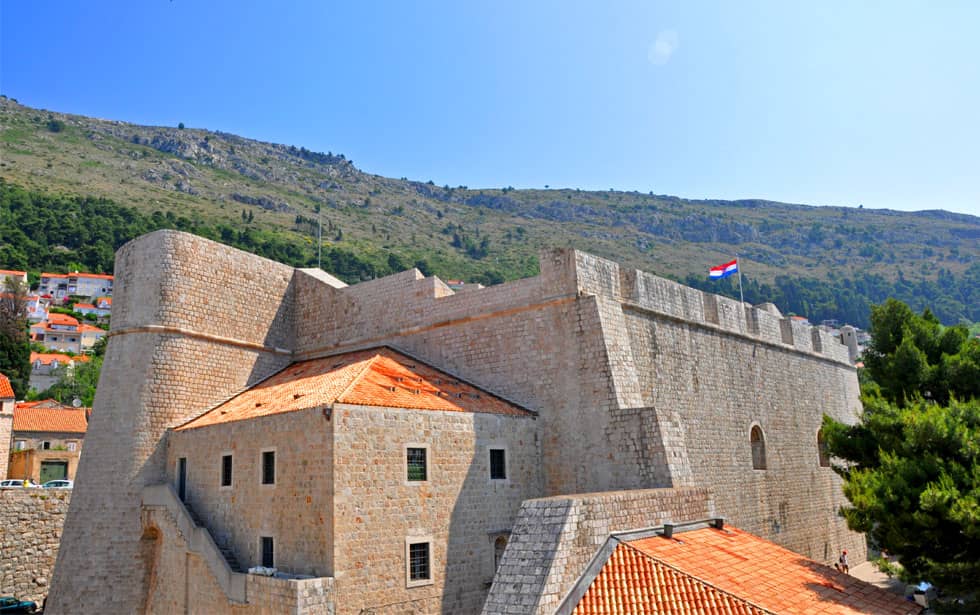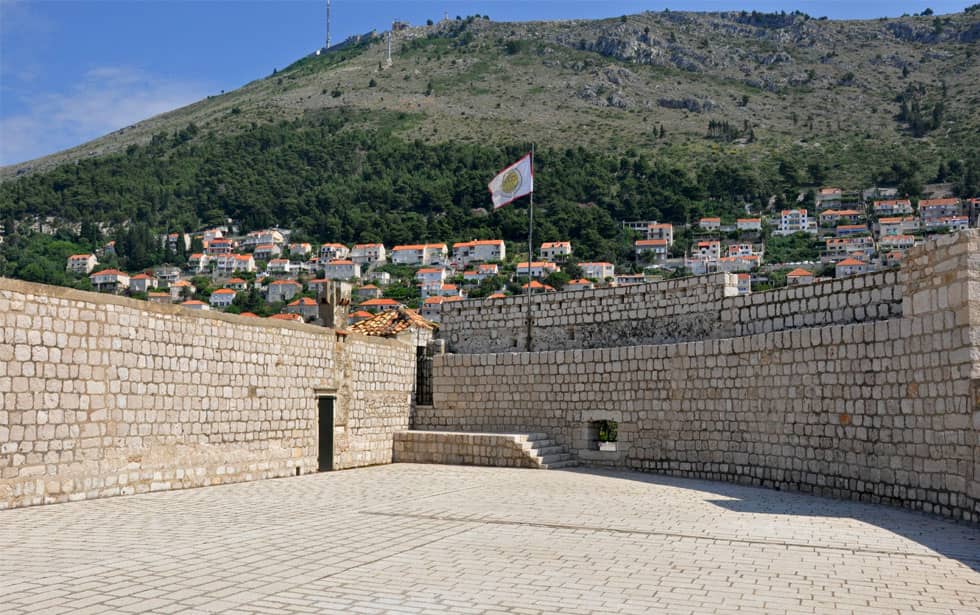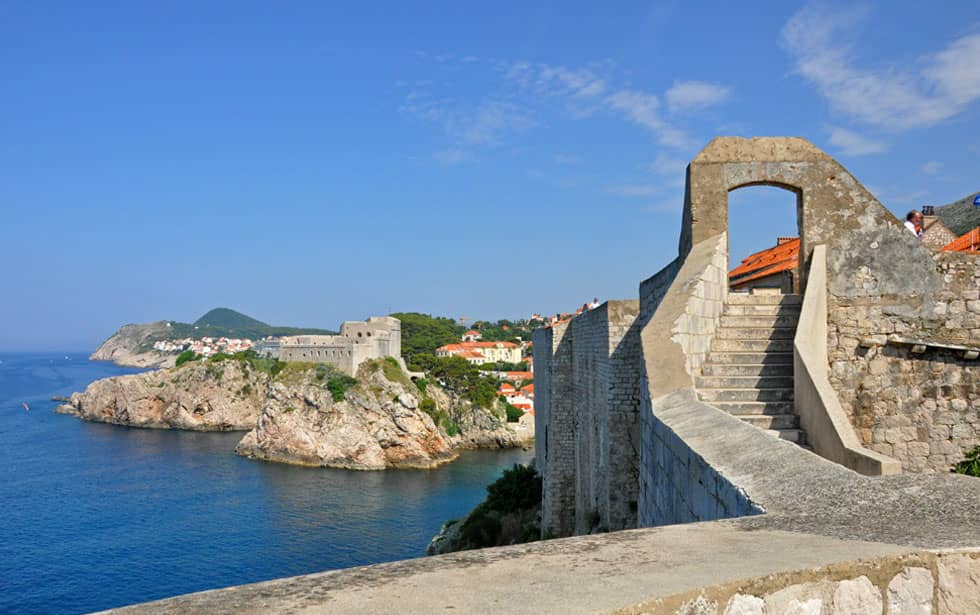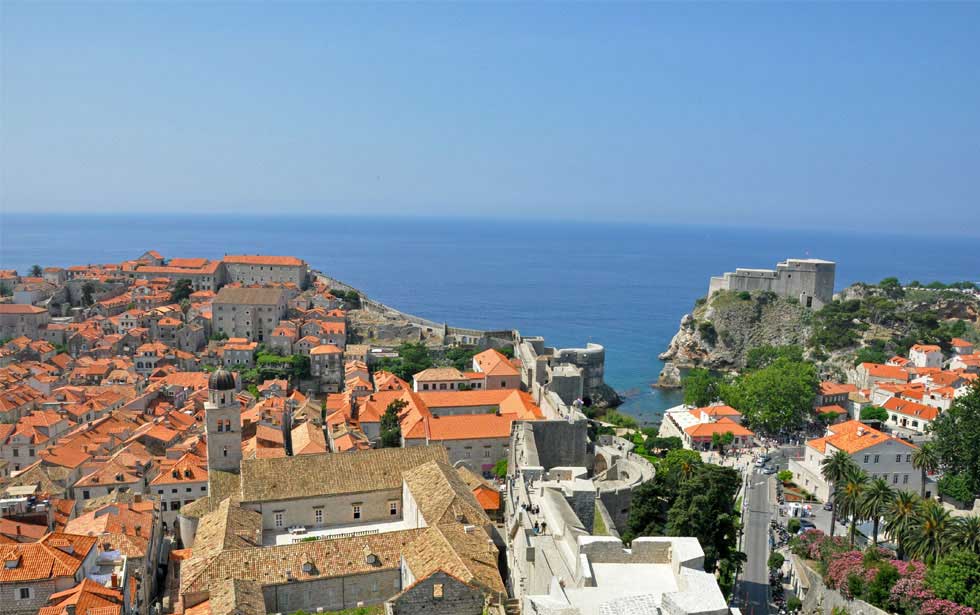The Dubrovnik City Walls were built from the 13th to the 18th century, constantly added to and strengthened, without ever having to be used for the purpose for which they were built, thanks to the skilful diplomacy of Dubrovnik.
Even before uniting the two settlements that later on formed Dubrovnik, high wooden walls were erected at the southern part of the town which then still were only rock clusters. In the 13th century when the channel (today Stradun street) had been filled in, the walls were connected with the settlement that was under Srđ hill.
Dubrovnik Super Saver:
Cable Car Ride and Old Town Walking Tour plus City Walls
Embark on an unforgettable journey through the stunning city of Dubrovnik, renowned for its breathtaking architecture and rich history. Stroll along the narrow and winding streets of the UNESCO World Heritage Site of Dubrovnik Old Town. Be awe-inspired by the mesmerising views from the 16th-century city walls, and take your experience to the next level by taking a cable car ride to Mt. Srd for panoramic views of the city.
Book your tour now and discover Dubrovnik with a knowledgeable tour expert.
The whole area was encircled by a stone wall with turrets. When the Dominican Monastery was built in the 14th century this part was also included within the walls. Though, two fortresses remained outside the walls - Lovrijenac on the west and Revelin on the east, built in the 17th century.
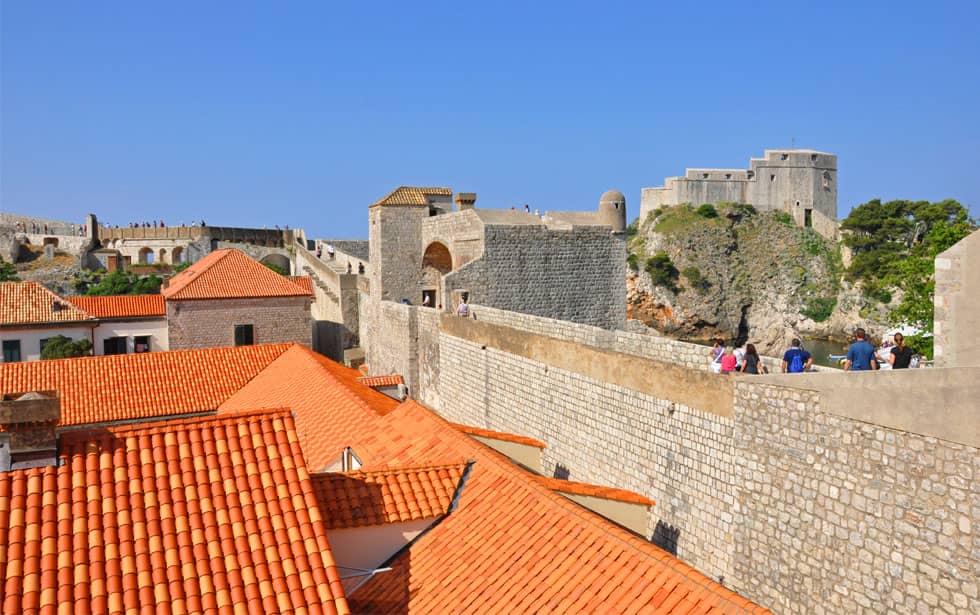
The walls are 1940m long and reach a maximum height of 25m. The thickness of the inner wall on the seaside is between 1.5 and 3 meters while the landward side of the wall thickness of an average of about 4 meters. In some places a thickness of up to 6 meters. They consist of the main wall, sixteen towers, three forts, six bastions, two corner forts, three pre-walls with several turrets, three moats, two barbicans, two drawbridges and a breakwater.
This historical monument is one of the world's rarities by its dimensions, construction and the architectural harmony of lines and proportions. It kept the Dubrovnik Republic protected and safe and allowed a community of civilised and sophisticated residents to flourish in peace and prosperity for five centuries. The stone for the construction came from a limestone quarry in Dubac, near Brgat village on the opposite side of the hill. The original mortar was a mix of seaweed, eggshells, and sand from the nearby Neretva River. Legend has it that during the Middle Ages, when the city’s leaders decided to fortify the walls against the potential threat of Ottoman invasion, each person entering the Old Town of Dubrovnik was required to bring a stone proportional to their size to contribute to the building of the city’s fortifications.
Dubrovnik Combo: Old Town & Ancient City Walls
Discover why Dubrovnik is known as the 'Pearl of the Adriatic' on this guided tour of the Old Town and its impressive, centuries-old City Walls.
Explore monasteries, churches, palaces, and merchant houses as you learn about the rich history of Dubrovnik. Then, ascend to the City Walls for breathtaking views of the town and the Adriatic Sea.
Attractions you will see include Orlando's Column, the City Bell Tower, the Rector's Palace, the Church of St. Blaise, Fort Revelin, Minčeta Tower, Fort Lovrijenac and much more... Explore Fort Lovrijenac independently, the only fort separated from the City Walls
Book your tour now and discover Dubrovnik with a knowledgeable tour expert.
If you plan to visit museums and other top attractions in Dubrovnik, including the City Walls, you can save up to 50% by getting a Dubrovnik Card.
Two prominent fortresses played a crucial role in defending Dubrovnik's Old Town. The Revelin Fortress, an irregularly shaped quadrilateral fort near the eastern walls, now houses the city's archaeological collection and serves as one of Dubrovnik's most popular nightclubs.
On the opposite side, the formidable Fort Lovrjenac (Fort of St. Lawrence) stands atop a 37 meter (121 foot) high cliff, guarding the western approach to the Old Town. The 12-meter-thick wall facing the sea provided a buffer against Venetian maritime attacks, while the wall facing the city was much thinner. Today, Fort Lovrjenac transforms into a Shakespearean stage during the famous Dubrovnik Summer Festival. Above its entrance, a 13th-century Latin inscription reads "non bene pro toto libertas venditur auro" - freedom should not be sold for all the gold in the world.
Other fortresses include Bokar, St. John, and Minčeta. The Maritime Museum, along with an aquarium, is located within the 15th-century Fortress of St. John in the Old Town Port.
While walking along the northern section of the City Walls, you may notice Jewish gravestones integrated into the structure. These tombstones originally came from a nearby Jewish cemetery, located just outside the wall in the Jewish quarter. During a time when stone was in short supply, city authorities decided to use the gravestones to reinforce the fortifications, prioritizing public safety with the motto: obliti privatorum, publica curate (forget private matters, focus on public ones). Dubrovnik also boasts the oldest active Sephardi synagogue in the world and the second-oldest in Europe.
Walking the Walls
The best views of Old Town Dubrovnik are of course from the walls themselves and to miss a stroll around them is missing the true essence of Dubrovnik. Looking upon the bleached white underwear hanging to dry in a convent's courtyard makes you think that life here has been going on in the same manner for decades. There are a few access points and we recommend using the one between Ploče gate and the city port - it tends to be less crowded. Another entrance point is just beyond Pile gate as you step into Old Town Dubrovnik.
Because of its monumental walls and well preserved cultural monuments, Dubrovnik has been included in UNESCO's Register of World Architectural Heritage (Luxor, 1979.)
Where are the entrances to Dubrovnik City Walls
Got your Dubrovnik Pass and sunscreen? Great! Now, where to begin? Finding the Dubrovnik City Walls entrance is a breeze. The main and most popular entry is just past Pile Gate on Stradun Street.
City Walls Entrances: Pile Gate (main entrance), Ploče Gate near St. Lukes Tower and St. John’s Fortress near the Maritime Museum
Pro Tip: Start at the entrance for the most stunning views of the sea, Old Town and Lovrijenac Fortress. But if the Old Town is packed during peak season, skip the crowds and head to the St. John’s Fort entrance—it’s quieter and has little to no lines!
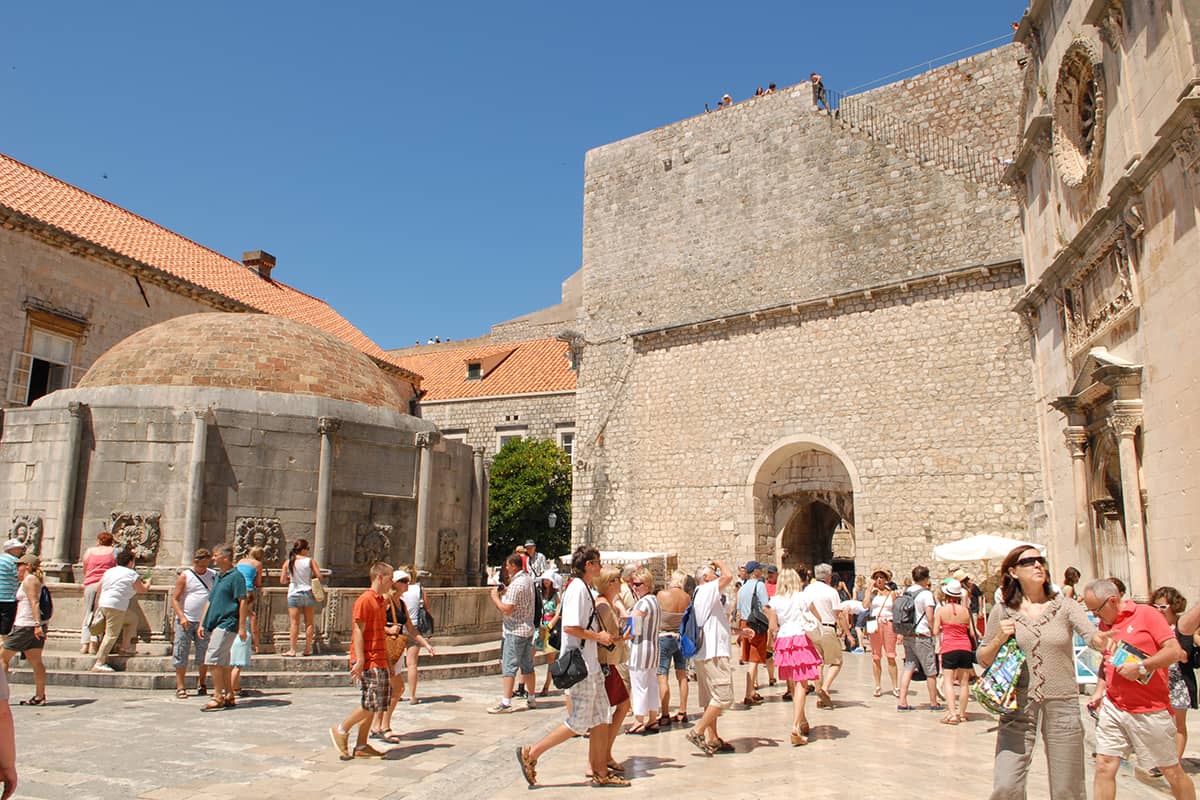
City Walls Tickets
Ready to explore the breathtaking Dubrovnik City Walls? You’ll need a ticket and getting one is simple! Pick it up at the entrance gates or grab it online at the official webshop.
Ticket Prices: Adult tickets are €35, and children aged 7 to 18 can enter for just €15. Students with an International Student Card (ISIC) or European Youth Card get a sweet deal at €15. Just remember, only physical cards are accepted—no virtual cards or local student IDs allowed.
Here’s the good news: your ticket now includes access to the Western Outer Wall, a hidden gem that runs between Fort Bokar and Fort Minčeta, offering stunning views and fewer crowds. Your ticket, once scanned, is valid for 72 hours, giving you plenty of time to explore the City Walls, Lovrijenac Fort, and the Western Outer Wall—all within three days. But note: you can only visit each site once.
Pro Tip: Skip the hassle and extra fees by avoiding third-party sellers. Purchase your ticket directly at the gates or online to dodge the 25%-40% markup! While €35 might seem like a splurge, the jaw-dropping views, fascinating history, and the knowledge that your ticket helps maintain this UNESCO treasure make it absolutely worth it!
Dubrovnik Pass
A smarter option than purchasing individual City Walls tickets is to go for the Dubrovnik Pass. With the Dubrovnik Pass, you get access to 12 top attractions, including the iconic Rector's Palace and the fascinating Ethnographic Museum. Best of all, it grants free entry to the Dubrovnik City Walls!
Why choose the Dubrovnik Pass?
It offers free public bus transport while your pass is active. Skip the long lines at included attractions and enjoy discounts on extras like boat trips and guided tours.
The Dubrovnik Pass comes in three versions:
1-Day Pass: €35, 3-Day Pass: €45, 7-Day Pass: €55
Considering that the City Walls ticket alone costs €35, the Dubrovnik Pass offers good value with all the added perks for the same price!
Dubrovnik City Walls opening hours schedule
| Date | Open Hours |
|---|---|
| 1 January – 28 February | 10:00 – 15:00 |
| 1 March – 31 March | 09:00 – 15:00 |
| 1 April – 31 May | 09:00 – 18:30 |
| 1 June – 31 July | 08:00 – 19:30 |
| 1 August – 15 September | 08:00 – 19:00 |
| 15 September – 31 October | 09:00 – 18:00 |
| 1 November – 31 December | 09:00 – 15:00 |
Quick Visitor Highlights
- The walls stretch about 1.94 km (around 1.2 miles) and reach up to 25 m in height.
- Entry points include the iconic Pile Gate and quieter Ploče Gate.
- Walking the full loop typically takes 1.5–2 hours, depending on pace and stops.
- Tickets cost approximately €33–35, or are included with the Dubrovnik Pass, which offers extra perks like free transport and access to other attractions.
- The walls offer sweeping views of the Adriatic Sea, red-tiled Old Town rooftops, Lovrijenac Fortress, and even views toward Lokrum Island.
- It’s wise to visit early morning or late afternoon—both to beat crowds and avoid the summer heat.
Working Hours
Summer 08.00 - 18.30/19:30
Features
Pets are allowed but they must be on a leash.
Frequently Asked Questions (FAQ)
Are Dubrovnik City Walls free?
How long does it take to walk the Dubrovnik City Walls?
What is the best time to walk Dubrovnik walls?
Where do you start at the Dubrovnik Walls?
Best footwear for walking the Dubrovnik Walls?
Stay hydrated and bring water
Address & contact details
Street: Old Town Dubrovnik
Postcode: 20000
City: Dubrovnik
Website: Dubrovnik City Walls
Where to stay in Dubrovnik
Our top picks for where to stay in Dubrovnik.
